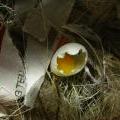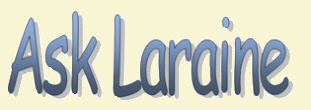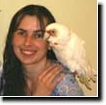Breeding Issues in Gouldians & Other Finches
Kristen Reeves, Meadowlark Farms Avian Supply, Inc.
There are several issues that can come up when breeding your birds. Most of these can be solved or avoided with proper nutrition and good condition.
EGG BINDING
Egg binding is a very serious and potentially deadly condition that can be caused by a number of issues such as:
- Poor nutrition or lack of calcium
- Poor condition (the bird is not in breeding condition)
- Too young or too old hen
- Over sized egg or one that has come down in the wrong position (not unlike a posterior birth in humans)
- Sudden temperature changes or too low a temperature
- Small hen
- Lack of required muscle tone
- Inadequate exercise
- Infection in the ovaries, uterus or cloaca
An egg is formed in the ovary and when complete, moves to the cloaca to be expelled through the vent. In egg binding, the egg has become lodged in the ovary or somewhere between ovary and cloaca, giving the hen difficulty pushing it out.
Egg binding can also happen when an eggshell has not developed properly. This may mean she has not had enough calcium, or the bodily function that forms the shell is not working properly to deposit the calcium onto the shell. A soft-shelled or clear egg won't travel down properly. It may get stuck, hence causing the egg binding issue. If nothing is done to help her, the hen will exhaust and kill herself in an attempt to expel the egg.
Symptoms of egg binding - An egg-bound hen will look dreadfully ill. She will sit fluffed up, usually on the bottom of the cage, and will barely move. Her eyes may be closed or half closed. She may be panting or even experiencing tremors. Her legs may appear to be paralyzed. You will have no problem catching her - in fact, she probably won't fight you at all because she is in a weakened state from the effort of trying to expel the egg. If you take her in your hand, you may be able to feel or even see a yellowish or whitish area in her abdomen just above the vent unless the egg is lodged higher up. This is the mature egg. If the egg is higher, heat and calcium will be your most important treatments.
If you have even the slightest inkling that you have an egg-bound hen, you must immediately get her into a 90 to 95 degree hospital cage. Syringe dosing her with straight calcium such as Morning Bird's Calcium Plus and adding extra calcium to her drinking water will also help. She may not accept the calcium, so place the tip of the syringe at the corner of the beak where upper and lower meet and the beak attaches to the head. Express a single drop at a time. The beak will act as a sponge and pull the calcium in. The swallow reflex will ensure the birds receives at least SOME of the calcium. If you are unsure of your skills, you should immediately take her to an Avian Veterinarian to have the egg extracted or she may die. If you are an experienced breeder, you can try to assist the hen by inserting a small catheter into the cloaca and injecting a small amount of warm mineral oil. The mineral oil acts as both a stimulant and lubricant to help the hen push the egg out. Only attempt this if you have every confidence that you know what you are doing as you can rupture the cloaca, uterus (if prolapsed) or the egg inside the hen. All of these issues can be extremely serious or even deadly to the hen.
Another method old-time breeders used to release a stuck egg is explained below:
Steaming: This term refers to an old established method used by many breeders for all species of cage birds and involves filling a non breakable container with boiling water; cover the container with a thin cloth allowing steam to filter through the fabric. The vent area of the bird is then held within the steam; taking care not to burn the bird or damage the egg. The heat vapour can be judged by the hand holding the bird and therefore gives a guide as to the temperature of the steam being emitted.
***More information can be found on the Appleby Farm website http://www.canaryzoo.com/bird%20specie%20gouldian%20finch.htm
PROLAPSED UTERUS
This is another serious issue typically caused by lack of calcium in the hen that may sometimes present if a hen is having a difficult time expelling an egg.If you find this issue, it is imperative you keep the prolapse clean. If there is seed, hulls, feather dander - ANYTHING - stuck to the prolapse, you must carefully clean the area. Here, I massage a single drop of mineral oil into the cleaned prolapse and gently push it back into the hen's body with a mineral oil coated cotton bud (Q-tip). In most cases, the prolapse SHOULD stay in the body, but sometimes it will continue to come back out. It is important to keep the area clean until the body pulls the prolapse back in on its own. If it does not, the hen may die. Veterinary care may be necessary.
SOFT-SHELLED EGGS
This is the egg the hen pictured above has laid. It is a soft-shelled egg. The makeup of this egg tells me the hen is in desperate need of additional calcium. She will continue to receive a higher amount for the remainder of her “resting” season, and throughout the year.
Notice how the shell is not hard or formed. The edges are curling because the 
CLEAR EGGS
When a pair of birds produces eggs, there are two parts - the egg itself created by the hen [with the shell, yolk, and white (albumin)], and then the sperm created by the cock bird which fertilizes the egg. If an egg has no yolk, it means there is a problem with the hen. If the yolk is present and the parents are brooding but the egg never gestates, it could mean there is a problem with the cock. Either problem could be a sterility issue, but could also be a nutrition problem, or “not quite in condition” problem and the birds haven't raised their internal temperatures to incubate the eggs.
Clear eggs are eggs that have no yolk – these are obviously infertile. This could be caused by something as simple as incomplete copulation, or it could be a more serious problem caused by improper breeding condition, poor nutrition, a lack of calcium or vitamin D3 in the proper ratio with phosphorus, or even a bacterial infection in the pair; hen, cock or both. In most cases, proper nutrition should solve this problem, but if you are still having problems, you should first test the pair for a bacterial issue. If it comes back negative, separate the pair and allow them to wait another season before trying again.
CALCIUM & VITAMIN DEFICIENCIES
A calcium deficiency can cause more problems than just egg binding in hens. It can cause brittle bones, poor feathering, beak and claw issues, considerably degraded condition, and a loss of life if severe.
While calcium is not as critical for cock birds because they do not create eggs, it is still very important to their overall health. Hens require calcium to produce eggs. They store calcium in the long bones of their bodies during the resting season, and draw upon that store to supplement their dietary intake as they produce those eggs during the breeding season. If a hen does not receive enough calcium or does not have the ability to absorb the calcium she is receiving, she may become egg bound or produce soft shelled and/or clear eggs. Remember, vitamin D3 in proper combination with phosphorus and magnesium is required to process calcium. You birds must receive the proper amount of both to adequately absorb the calcium they need to produce viable eggs. A good vitamin supplement with all necessary vitamins and minerals, a good calcium supplement, and iodine supplement are highly recommended for the health and vitality of your birds. Iodine drives the thyroid. The thyroid drives many bodily functions, including breeding! Get the nutrition right and you'll have very few issues in your aviary.
EGG PECKING/EATING

COMPATIBILITY
Sometimes compatibility issues can cause breeding problems. If a hen does not like the mate you've chosen for her, she may fight with him or fly away when he attempts to court her. In a case like this, IF she produces eggs at all, she may only produce one or two and rarely a full clutch.
Because I keep my birds in same sex flights when they are not breeding, I do not usually have problems with my pairs. However, if the hens are able to see the males before I am ready for them to be paired, chances are they'll choose their own mate then refuse the one I've chosen for them.
The best way to prevent compatibility issues is to keep your hens and cocks in separate flights where they cannot see each other. Run them through an austerity period so that they fall out of condition at the same time. Once you being the breeding diet again, they should all come back into condition about the same time too and will be ready to breed with just about any mate you select for them. Austerity serves to shrink the breeding organs, stop breeding hormones, and help the bird drop extra weight gained during the breed/molt or resting diets. A fat bird (cock OR hen) may produce infertile eggs, or fail to breed altogether.
There is some conflict about head colors and allowing birds to choose their own mates. I have never paid heed to that conflict and have always chosen my pairs myself. In nearly 20 years, I've only had one or two hens who just wouldn't mate with the cock bird I selected for her. I have not seen the head color incompatibility issues some breeders have, either. However, I tend to pair like head colors in most cases - because I prefer to breed true. I want pure birds with no loose genes flying around in their system! When I do pair different head colors, the outcome is always just as good as if the birds are the same head color. Same number of eggs, chicks, and chick:adulthood rate. This is just my experience, so try it for yourself and judge based solely on your own experiences! ~k





